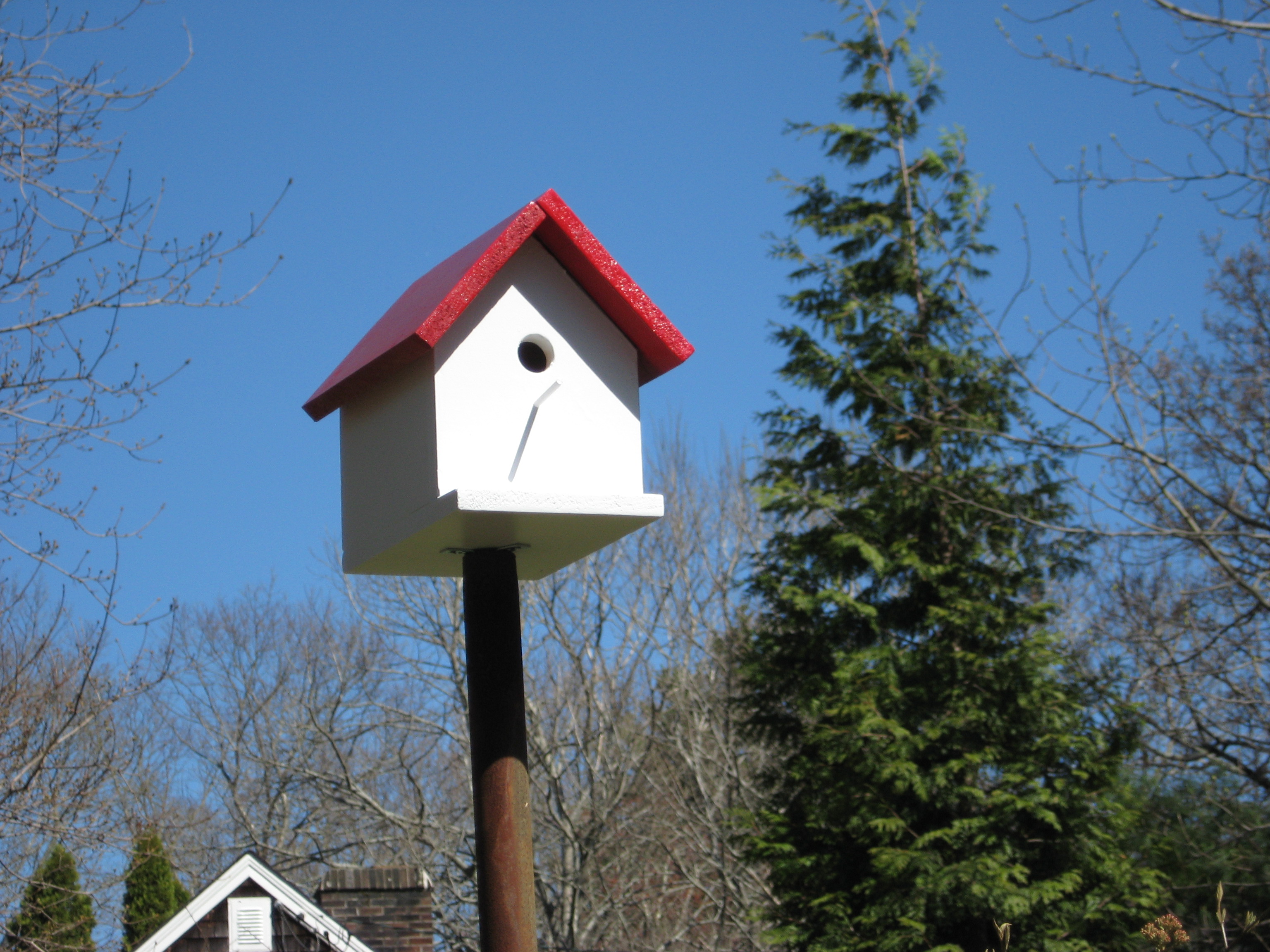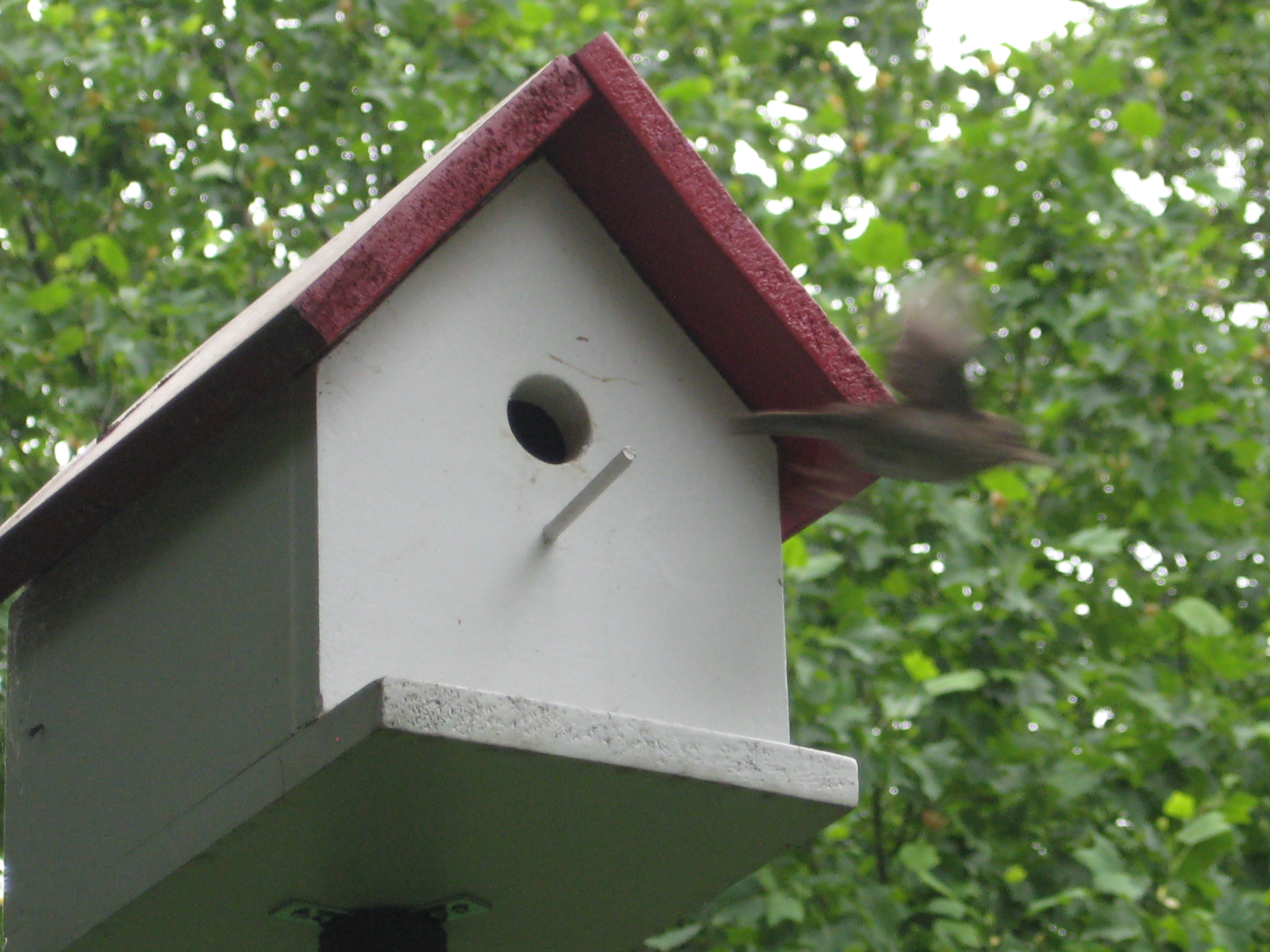Why should the wee chap called the house wren belong to the family Troglodytae? I thought a troglodyte was a slang word for a caveman, like good old slope-browed Alley Oop, or any pre-homo sapiens humanoid. Urban Dictionary is neither illuminating nor entertaining for the entry, though Free Dictionary refers to a troglodyte as a “curmudgeon attached to an obsolescent computing environment.” Ha! That works.
But back to the wren. The new birdhouse in our backyard is home to a second family of
wrens this season. Two days after the four siblings in the first crew flew off, another wren started to clean out the nest, make one of its own, and start a family. I built the house so that the north side of the sloping roof is attached to the frame with velcro, making for easy annual cleaning by this humanoid. I’ve been tempted to lift off the roof to get a pic of this second fam but have resisted. I don’t want to stress the poor guys by leering in like The Amazing Colossal Man.
The first birdhouse was a kit given to son Nick by his aunt, my sister Kathye. A great gift. Nick was about seven, put it together with hammer and nails, and painted it blue and white. He even crafted a faux chimney for it. It lasted seventeen years, finally demolished in the fall of 2010 by a woodpecker that used it for warming up exercises. The front and roof collapsed inward. Time for a new one.
I measured what was left of Nick’s house and made this one about twenty-five percent bigger. Painted it red and white. Put it up in mid spring of this year. The For Sale sign came down in less than a week. And, of course, the occupant was a house wren, the little bullies of the backyard bird world, noisy, fast-flying bundles of energy whose incessant high-pitched trills and squeaks will drive you bonkers if you can’t learn to tune them out. The male announced possession by perching on the roof and singing loudly and repeatedly for a few days, then the nest building began, with endless trips in out of the house with small twigs and dried stems. Some of the longer sticks proved a problem. Imagine Buster Keaton trying to get a ladder through a doorway, the wrong way. The poor wren is perched on the little dowel I installed under the hole, and he’s got a four-inch twig left to right in his beak and can’t get it into a one-and-a-half-inch diameter hole. It took him the better part of a day to figure it out, finally going inside the house to pull in the rest of the twig.
Seems that the male starts the nest as a way to attract the female. And sometimes the male leaves before the babies are fledged. I can’t tell male and female apart. No matter. One day the endless back and forth trips to the house are punctuated with a cheeping sound so high and fragile it’s almost imaginary. Yes, it’s the babies. They’ve hatched and are feeding. It happens so fast! The female makes a thousand trips a day, I’ve read, to feed the brood. Inchworms, small caterpillars, and grasshoppers. She finds a seemingly endless supply in Nonnie’s gardens, especially under and amid the low-hanging branches of the azaleas.
One June morning about 6:30, as we stared out the kitchen window silently before separating for the day’s work, I saw an odd movement at the birdhouse hole. Nonnie’s got the distance vision; I’m the closer upper. So I put down the coffee mug and grabbed the binoculars. “It’s a baby,” Nonnie said. “It wants to come out.” Time stopped. The two us entered a trance of shared attention and wonderment. For the first time, we would see a brood take flight.
What does it take to be the first bird to approach that hole from the inside? It’s impossible not to watch this miraculous process and attribute character traits to each bird. It’s dark and crowded in there (despite the architect’s generous design), none too sanitary, and increasingly noisy. The hole means light, air, food. The wing muscles must be busting with potential energy, just wanting to stretch out and achieve lift. So compulsion merges with need, and merges with desire, something deep in the cells compells, and the first little dude chins it up to the hole and sticks out his head.
“Holy crap,” the male humanoid says, capturing the fragile poetry of the moment.
His head is out, then his neck, then part of his body. Then a foot, followed by a leg! In a bizarre calisthenic, One looks like I once did as a kid trying to get into the bathroom window after locking myself out of the house. You can get stuck with this move. One’s foot reaches for the dowel perch, swings back and forth trying to snag it. Foot clamps tight. Now One gets scared–or seems to. One freezes. Look around. Now what! He (or she) tries to duck back inside, but his feathers fan outward awkwardly like an umbrella turned inside-out in a gale, keeping him from the safety of the house. Now he has to leave, and he doesn’t seem too happy. Ever so slowly, he wiggles his body outward, that first foot still clamped tightly to the perch. He’s out! I don’t want out, he says, as his other leg, now fully exposed, swings around and upward to grab the bottom the hole. What a spectacle! One leg is at twelve o’clock, one leg at six o’clock, and in between a bird unsure, wings flapping, head turning this way and that. A visual memory jostles loose: Bean, on the diving platform. (Long version. Short version.) He releases the top leg, and swings downward like a pendulum to a porch-like lip that extends from the base of the house. He’s out and on the ledge. Now Two has stuck his head out and is squawking at One to beat it!
In a flash, Two is out of the hole and flying away–a split second, as if no need for thought and decision. C’mon, One! And as Three sticks out his head, One flies off. Go, One! Three comes out quickly but lingers on the perch. He rather likes the view. But Four comes out and pushes Three off the perch, forcing him to take wing. Four plops down rather awkwardly on the porch, looks about, and flies away.
Whether the male is still around we can’t tell, but there at least five wrens in the backyard now, all making noise, all flying like maniacs, dive-bombing each other, and landing in the azaleas and viburnum. By afternoon, they were gone. These dramatic leave-taking took about fifteen minutes. We agreed it belonged with the Splendid Unforgettable Moments. Thrilling.
So why the Troglodytae family name? Beats me. I’ll have to get back to that.
Incidentally, Alley Oop was created in 1932 by illustrator and cartoonist V.T. Hamlin, an interesting guy. His middle name was Trout. He joined the Army at 17, serving with the American Expeditionary Forces in France during World War I. While recovering from a poison gas attack, he started illustrating the letters that his fellow soldiers were sending home. One thing led to another, as is destiny’s wont.




Официальный вход на сайт Casino vavada для любителей азартных игр, предлагающий широкий выбор слотов, бонусы и возможность выигрыша реальных денег.